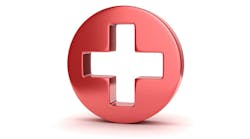CDC said it is “tightening” previous infection-control guidance for health care workers “to ensure there is no ambiguity” on how to choose, don and doff the proper PPE when caring for Ebola patients.
The agency said the guidance reflects best practices from the safe treatment of Ebola patients at Emory University Hospital, Nebraska Medical Center and National Institutes of Health Clinical Center.
The enhanced guidance is centered on three principles:
- All health care workers undergo rigorous training and are practiced and competent with PPE, including taking it on and off in a systemic manner.
- No skin exposure when PPE is worn.
- All workers are supervised by a trained monitor who watches each worker taking PPE on and off.
All patients treated at Emory University Hospital, Nebraska Medical Center and the NIH Clinical Center have followed the three principles. None of the workers at the facilities have contracted the illness.
Principle 1: Training
Focusing only on PPE gives a false sense of security of safe care and worker safety, CDC says. Training is a critical aspect of ensuring infection control.
Facilities need to ensure that all health care providers practice numerous times to make sure they understand how to appropriately use the equipment, especially in the step by step donning and doffing of PPE. CDC and partners will ramp up training offerings for healthcare personnel across the country to reiterate all the aspects of safe care recommendations.
Principle 2: No Skin Exposure
Given the intensive and invasive care that U.S. hospitals provide for Ebola patients, the tightened guidelines are more directive in recommending no skin exposure when PPE is worn.
CDC is recommending all of the same PPE included in the Aug. 1, 2014 guidance, with the addition of coveralls and single-use, disposable hoods.
Goggles no longer are recommended, as they might not provide complete skin coverage compared with a single-use disposable full-face shield. Additionally, goggles are not disposable and might fog after extended use, and health care workers might be tempted to manipulate them with contaminated gloved hands, the agency said.
PPE recommended for U.S. health care workers caring for patients with Ebola includes:
- Double gloves.
- Boot covers that are waterproof and go to at least mid-calf or leg covers.
- Single-use fluid-resistant or impermeable gown that extends to at least mid-calf or coverall without intergraded hood.
- Respirators, including either N95 respirators or powered air-purifying respirator (PAPR).
- Single-use, full-face shield that is disposable.
- Surgical hoods to ensure complete coverage of the head and neck.
- Apron that is waterproof and covers the torso to the level of the mid-calf should be used if Ebola patients have vomiting or diarrhea.
The guidance describes different options for combining PPE to allow a facility to select PPE for its protocols based on availability, health care personnel familiarity, comfort and preference while continuing to provide a standardized, high level of protection for healthcare personnel.
The guidance includes having:
- Two specific, recommended PPE options for facilities to choose from. Both options provide equivalent protection if worn, donned and doffed correctly.
- Designated areas for putting on and taking off PPE. Facilities should ensure that space and lay-out allows for clear separation between clean and potentially contaminated areas
- Trained observer to monitor PPE use and safe removal.
-
Step-by-step PPE removal instructions that include:
- Disinfecting visibly contaminated PPE using an EPA-registered disinfectant wipe prior to taking off equipment.
- Disinfection of gloved hands using either an EPA-registered disinfectant wipe or alcohol-based hand rub between steps of taking off PPE.
Principle 3: Trained Monitor
CDC is recommending that a trained monitor actively observe and supervise each worker taking PPE on and off. This is to ensure that each worker follows the step-by-step processes, especially to disinfect visibly contaminated PPE. The trained monitor can spot any missteps in real time and immediately address.
The agency emphasizes that PPE is only one aspect of infection control. It is critical to focus on other prevention activities to halt the spread of Ebola in health care settings, including:
- Prompt screening and triage of potential patients.
- Designated site managers to ensure proper implementation of precautions.
- Limiting personnel in the isolation room.
- Effective environmental cleaning.
'Think Ebola' and 'Care Carefully'
The CDC reminds health care workers to “Think Ebola” and to “Care Carefully.”
Health care workers should take a detailed travel and exposure history with patients who exhibit fever, severe headache, muscle pain, weakness, diarrhea, vomiting, stomach pain and/or unexplained hemorrhage.
If the patient is under investigation for Ebola, health care workers should activate the hospital preparedness plan for Ebola, isolate the patient in a separate room with a private bathroom and ensure that standardized protocols are in place for PPE use and disposal.
Health care workers should not have physical contact with the patient without putting on appropriate PPE.
